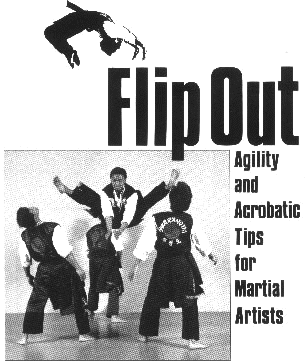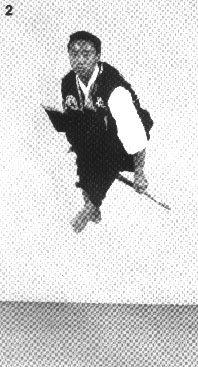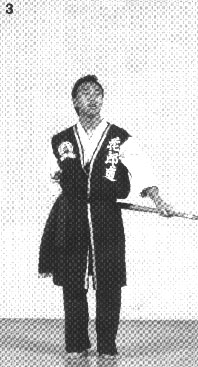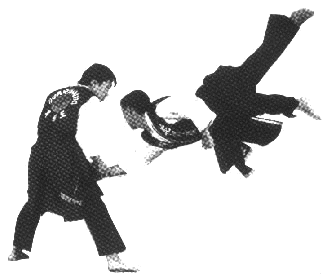
(Martial Arts Training Magazine - Summer, 1988 Issue)

All of us have seen those kung fu films where people are flying, flipping, and jumping their way around at world-record heights. You probably wondered after the movie, "is it really feasible to jump and flip that high?" Of course not. It's only fantasy and the make-belive world of the movies. However, sensational stunts give martial artists an opportunity to visualize the impossible and thus challenge their own human limitations. These acrobatic skills, which require agility, balance, coordination, strength and speed, are the ultimate expressions of body control. And with persistance and some patience, you can improve your agility and achive some incredible results.
In the Korean martial art of Hwa Rang Do, the most important philosophy which runs through all forms of study is the understanding of the theory of Um and Yang (ying/yang). The theory of um and yang states that all things in nature exist in polar dichotomies: sun and moon, good and evil, sky and earth, light and dark, etc. By understanding this theory, you can then begin to grasp the purpose of training, which is achieving harmounious balance. Therefore, the development of your agility is necessary in order to balance against haviness and slowness. In other words, it is important to realize the potentials of the human body in all types of motion, wether it be slow, fast, light or heavy. If any of these areas are not developed, then there exists an imbalance which cannot bring the individual to a full realization of his potential.
Such thought process is necessary for the individual to develop concrete goals which will be the driving force in assuring his success. After such goals are set, the next step is to analyze the physical condition and the physical limitations of the individual. There are three key factors to consider before setting out to perform martial art acrobatics or any form of physical exercise for that matter: flexibility, strength, and endurance.
Flexibility
You must know exactly how far you can bend, turn and stretch, in order to
prevent injury and attain optimal results. Without good streching exercises
before a workout, you are bound to recieve pulled or torn muscles, tendons or
ligaments. The things to remember when stretching are:
Duration - many studies have shown that holding a stretch for less that one minute has no effect on the muscles and some say that more than a minute doesn't really help either. In my experience of training others, the most effective length of time for stretching is going as long as you can without having to feel like you're being tortured. The best way to stretch is to read a book or watch television while holding a particular position and extending your legs until a slight degree of pain is felt, then slowly increasing the stretch as the pain subsides.
Slow, constant pressure - when you are stretching, it is crucial not tomake any jerking motions. This will caouse injury and defeats the purpose of the stretch. A slow constant pressure must be applied without any quick movement. Some people have the tendency to jerk back when there is pain and this is very dangerous.
Strengthen the outer muscles - another important fact about stretching, which most people neglect, is strengthening the outer muscles while streching the inner muscles. You should not only stretch, but strengthen the muscles which are on the outer sides of the muscles being stretched. For example, if you strech the hamstrings or the back of the thigh, you should also exercise to increase the elasticity of the thigh itsef. This is the case bacause the muscles only posesses one function - contracting. Some people think the muscles have two functions - pushing and pulling. This notion is false and it is the reason why the outher muscles need to be developed to a point wher the stretch can be most beneficial.
Relaxation and breathing - the last, but the most important, is relaxing and breathing while stretching. Take a deep breath and slowly exhale while streching and relax your muscles by focusing on the breathing rather than on the stretching.
Strength
You must take time to measure your physical strengths. This is not so much
in the way of meassuring the pounds you can bench press or curl, but how effectively
you can manipulate your own body weight. While training for acrobatics, the
most important think is to realize that you must have full control over your
body weight in order to perform these acrobatic skills. There are three areas
to focus: arms, body, and legs.
Arms - the arms include mainly shoulders, biceps, triceps, forears, and wrists. There are many exercieses for the development of these areas but the most effective and practical are the regular push-ups, handstand push-ups, tricep push-ups, chin-ups, and bar dips. The thing to keep in mind when doing these exercises is that the body is the soldier and the mind is the general. In short, what the mind comands the body will follow. The most difficult part of these exercises lie in the middle of the set. The beginning is quite easy but once the middle is near, the mind thinks it is too far to the end to finish. At this point you must push yourself. Try starting the count over from one again until the end has been reached. That might help. These exercises should be done two ways: one, very slowly being totally conscious of every movement; two, very fast to develop those fast-twiching muscles as well as developing stamina.
Body - the body mainly consists of three areas: chest, stomach, and back. The most effective exercises to develop theses areas are pull-ups for the chest, sit-ups for the stomach and pull-ups and bar dips for the back. These are common exercises you can do on a daily basis without special equipment or attention.
Legs - there are many exercises for the legs. However, for martial arts acrobatics and agility, attention must be focused on gaining height on the jumps and a soft landing. One- and two-leg squats are great for developing the thighs. Jumpig in place for no less tha 15 minutes is a great way to develop the calves and increase andkle strength as well as improving the cardiovascular syste. Other exercises include bunny hops, duck walks (not recommended for those who have bad knees) and jumping over obstacles without pausing. All the jumping exercises must be done fast.



To develop height in your jumps, try this exercise Eric Lee is doing. With a
short staff or stick at your side (1), jump up, tuck your legs and bring the
stick underneath them (2). You should end up with the stick on the opposite
side of your body (3). Repeat the exercise.
Endurance
This will play a key role in determining the productivity of the workout
session. If you can only endure a small amount of time, then the productivity
in the workout is decreased. On the otherhand, in an individual is able to train
longer with the same amount of energy level throughout the workout without fatigue,
then more things can be accomplished. Keep in mind that you should end the workout
with a high energy level - feeling so good that you think you can go on training
for hours more. The way to develop this feeling is to make a portion of the
daily training session focused on endurance. It should be no less than 20 minutes,
and in this time, you must exercise slowly and constantly. I am a firm believer
that running is unhealthy, especially for the martial artist. I realize that
running is the most practical and effective way of developing endurance and
stamina. However, running creates many complications in the later years. It
causes the knees, ankles, hips joint, and the back to take a lot of beating
which ultimately results in decreased performance as you get older. Another
bad point about running is that it tightens the muscles and flexibility is drastically
reduced. Throughout my experiences in personal training, I have found people
who have played running sports like football, basketball and track and field,
have little or no flexibility at all.
Along with these three areas of training, there are two more which require attention - ballance and coordination. These two areas can be most effectively developed through the practice of hyung (forms). In Hwa Rang Do, there are numerous forms which help the individual gain greater skills in these areas. Not only does Hwa Rang Do have long forms, but it also has short forms which consist of fewer movements and are executed with greater speed in mind. There are also specific acrobatic, falling, tumbling drills, which are in nature like the short form.
Other ways to develop balance is by practicing the crane stance which is performed on one leg while standing on a log or a round object like a ball. A point to remember in these exercises is to breath slowly, keep the back straight at all times, and remain centered. To develop coordination, you must be a good observer. Coordination is simply being able to have your body do what your mind wills it to do. This can be improved by sending clear messages to the body, thus allowing the body to respond correctly. This can only be accomplished if you are able to observe the action in every detail.
After all these areas are developed, then you are prepared to
attempt some acrobatics. The first technique to start out with is forward and
backward rolls. Next, try to balancing on the hands pressed to a full handstand.
This is important for developing upper-body strength which will be necessary
to successfully execute cartwheels plus front and back handsprings. You must
have a spotter when practicing these exercises. The spotter must know exactly
what he is doing, for without a good spotter, injury is bound to occur. You
should not attempt any of the agility or acrobatic techniques without a qualified
instructor who knows about gymnastics or tumbling. Many martial arts instructors
are not fully qualified to teach anyone the finer points of tumbling, hence,
you must be careful in choosing a teacher. Otherwise, you can develop bad habits
which are difficult to correct. 
Acrobatic skills require a lot of patience and tenacity. In the advanced levels, back flips, front flips, aerials, laybacks, back laybacks, and virtually all forms of aerial techniques will be possible. However, another important aspect to work on is the landing. For this, you must spend a lot of time jumping, but not just jumping. When you jump, you must learn to tighten the dan jun, which is a ki (internal power) generating point located three inches below the naval. With this point tense, you must also tighten the body and think you are as light as a feather. The landing must be soft with the ball of the foot touching down first, then the heel as the knees bend. If you land on the heel with the knees locked out, severe damage to the ankles and back may result. To gain better health, you should learn to visualize a specific point as a target and imagine yourself trying to grab an imaginary bar and pulling the rest of the body up.
These acrobatic skills will allow more freedom in your physical motion and improve your overall martial arts skill level. Acrobatics are also applicable in performing demonstrations of empty hand and weapon forms. Possessing agility will allow you to move quicker without hesitation and react to situations with confidence. This mastery over the body with the development of power will create an invincible person. And if you maintain a healthy mind, you will truly be incredible.
As for these techniques applied in practical fighting situation,
it is limitless. Mostly, acrobatics will help with escape and evasion, but agility
skills will help in the counterattacks which are crucial in combat.
Hwa Rang Do emphasized the balance of mind, body, and spirit. In order to be
a complete martial artist, all three areas must be cultivated simultaneously.
This is the goal of the training, and with such high goals, the level of achievement
you can obtain is far greater than normal. The development of these acrobatic
skills through agility can only reach its zenith when accompanied by a high
goal of attaining a harmonious balance to achieve a peace of mind.